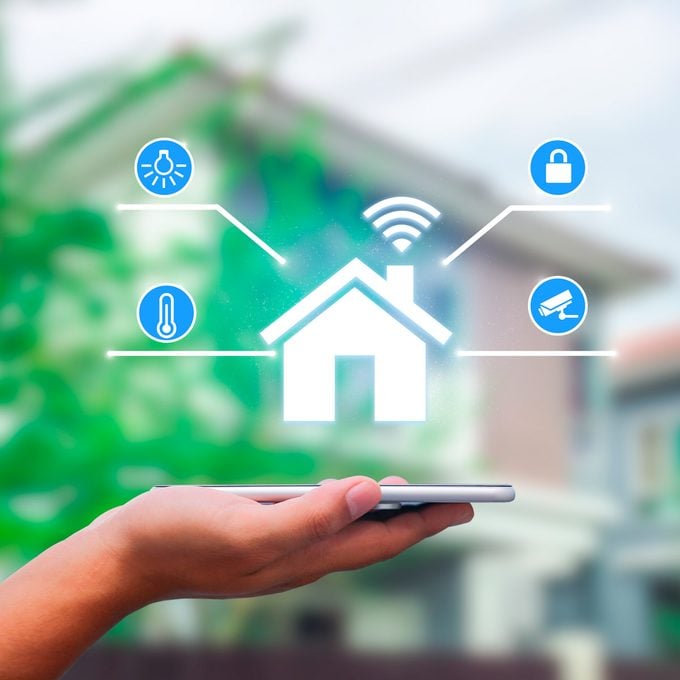A Guide to Home Automation Protocols
Updated: Jun. 04, 2024
If you’re ready to push your smart home boundaries, you’ll need a working knowledge of wireless standards, also known as smart home networking protocols. This technology lets the devices “talk” to one another, and to your Wi-Fi router, too.

If you’re like many smart home newbies, you’ve invested in one or two popular smart home products, such as a Phillips Hue lightbulb, or Nest thermostat. Maybe you’re riding the smart speaker wave, with a sassy Amazon Echo (“Alexa”) or an intentionally personality-less Google Voice Assistant (“Google”).
But there’s a vast smart home rabbit hole beyond, where refrigerators send low-milk alerts and solicitors stand idly on porch stoops, having been quickly identified by the security camera out front.
Looking for a great smart security camera? We have a few ideas.
If you’re ready to push your smart home boundaries, you’ll need a working knowledge of wireless standards, also known as smart home networking protocols. This technology lets the devices “talk” to one another, and to your Wi-Fi router, too.
There are two gadget languages invented specifically for the home automation market: Zigbee and Z-Wave. (We’re skipping wired networking protocols such as Ethernet, X10 or UPB, as well as hybrid wired-wireless protocols, such as Insteon and KNX, which are generally used by more advanced smart-home enthusiasts.)
The protocols discussed here are both “mesh networks.” That means that messages can hop from point to point to point, rather than directly to your router. Like the strands in a woven net, the more Z-Wave or Zigbee devices you own, the more stable your smart home infrastructure. That’s why technologists such as Ryan Herd, author of Join the Smart Home Revolution (RTH & Sons, 2017), recommend buying gadgets that are protocol-compatible. “As a consumer I need to know: Do I have any other stuff that can talk that way?” he says, explaining how that shared tech language then binds them to create a nice, solid foundation. “Make your wireless [protocol] as strong as possible, and then you’ll have a good base to build on.”
— First, you will need a “hub” to connect all the pieces of the puzzle. This can be a manufacturer’s proprietary hub, such as the Philips Hue Bridge, or an Amazon Echo. A “hub” can also be a smart home controller, such as Samsung’s SmartThings or Hubitat’s Elevation. As with Zigbee, you will need a “hub” to connect your devices into a seamless whole.
You can use devices that use different protocols if you use a hub that is compatible with both, such as a SmartThings. Your “mesh” for both won’t be as strong, but it is possible with careful gadget-buying. If you want more options, check out this affordable DIY-friendly Raspberry Pi home automation system.
Zigbee Smart Home Protocol
History: The first Zigbee-compatible products hit the market in 2006. In 2017, Zigbee introduced dotdot, a change to its design that the company hopes will make it the “universal language of The Internet of Things.” Tech experts are so far playing wait-and-see.
Zigbee Pros: Transmission rate is faster than Z-Wave. Plus, you have up to 65,000 connected devices in your “mesh,” a plus over Z-Wave. Also, Zigbee allows unlimited “hops” in the mesh infrastructure, while competitor Z-Wave is limited to four. As a practical matter, technologists assume 60 feet of signal per hop, although you may get more if you plan well and don’t attempt to signal through brick or concrete walls.
Zigbee Cons: Zigbee shares a radio frequency band with both Wi-Fi and Bluetooth, and so interference can be a problem. Also, the Zigbee Alliance is not as strict with certification as its competitor, so sometimes two Zigbee devices don’t communicate with each other well due to programming differences between manufacturers. Zigbee can connect devices from about 60 feet away—a much shorter distance than Z-Wave.
Zigbee Connected Brands: Amazon, Google, Bosch, Hive, Honeywell, Ikea, Comcast
For IKEA tech-friendly gadgets, see our on-trend guide.
Z-Wave Smart Home Protocol
History: Danish company Zensys developed Z-Wave in 2001. In 2018, Silicon Labs acquired the startup’s Z-Wave technology.
Z-Wave Pros: Works on a much lower radio frequency band than Zigbee, so there’s a much lower chance of interference. Z-Wave also requires strong encryption for any company selling its product as “Z-Wave Certified,” so the system is considered much more hack-proof. Z-Wave can connect devices up to a whopping 550 feet away.
Z-Wave Cons: Can only connect 232 gadgets, although that’s plenty for most smart home setups. A slower transmission than Zigbee speed means high-quality audio and video will likely gum up the works. (That’s why you won’t find Z-Wave security cameras.)
Z-Wave Connected Brands: Yale, Wink, Vera, GE, Honeywell, Kwikset, Logitech, LG, August smart locks
As for the future, Herd envisions a day when 5G wireless reigns, freeing consumers from worries about different protocols because Zigbee and Z-Wave will feel like snails in comparison. “But for now,” he says, “We’re still in a bit of a transition.”




















